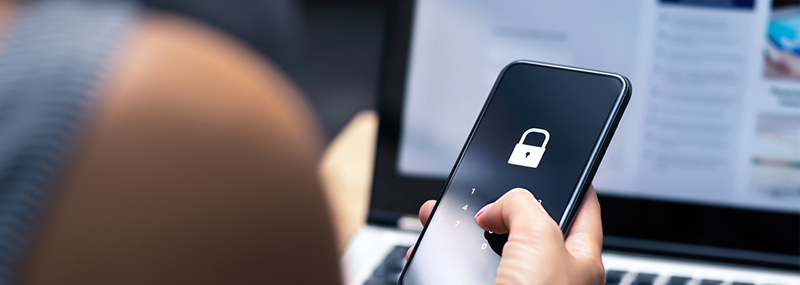You need to share personal information with doctors, financial companies, and other providers. As much as you try to keep your information private and secure, scammers and identity thieves work just as hard to obtain it.
Identity theft happens when someone steals your personal identifying information or financial information, usually for their financial gain.
According to reports from the Federal Trade Commission (FTC), cases of identity thefts have continued to rise over the years—reports show there are over 400,000 cases during the first quarter of 2025, and growing.1
There's good news though. Due to the effectiveness of preventive measures and increased consumer vigilance, you can reduce those chances. With the help of advanced technology, financial institutions and other companies can use your digital information—your email address and phone number— to help safeguard your confidential information, identity, and money.
Digital and paper communications
While communicating digitally is popular, most organizations still send paper statements via mail; however, paper documents can be highly vulnerable to theft. Physical documents can be stolen from mailboxes, taken during a burglary, or lifted from the trash. They may offer useful information to scammers, including Social Security numbers, health information, bank account numbers, and other sensitive data. Digital communication may be more convenient. It can also be more secure than paper, but there is still risk involved.
Easy steps for powerful protection
You can establish strong defenses against criminals using your digital identity, such as usernames and passwords, and through your email address and cell number.
One key defense is called multi-factor authentication, a layered approach to security that requires more than the use of your password to confirm your identity before accessing your account. When multi-factor authentication is used, it generally entails:
- Step 1: Logging in with your ID and password.
- Step 2: Verifying your identity another way, such as by entering a security code provided via text or email, or verifying through an authenticator app or push notification on your device.
An extra step at login not only helps prevent scammers from accessing your accounts and data, but may also give you peace of mind that your information is safe. Even if someone managed to obtain your login information, you'll receive notification or an alert of the suspicious activity. It's an added benefit because you would want to know immediately if someone unauthorized is trying to access sensitive data or change key information, for example beneficiary names or passwords. Text messages and emails can give you a heads-up to any potentially suspicious activity. This is especially important in cases where money could be transferred out of your account.
More ways to protect yourself
Following a few more best practices can help build your defenses even higher:
- Think twice before giving out sensitive information to anyone you don't know. Never provide personal or sensitive information to someone who has reached out using a phone number you don't recognize, or other types of unsolicited communication including text messages and voicemails. Scammers typically use urgent-sounding language, but don't take the bait. They may even replicate your phone number, call you from a similar one, or leave messages requesting a return call. When in doubt, reach out to your provider directly using publicly available contact information, and ask them to confirm the communication.
- Be wary of links and attachments you receive via email or text. Spoofing and phishing are cyberattacks that involves scammers impersonating companies or institutions by disguising either an email address, sender name, or phone numbers that appear to be from a trusted source. This can be done by slightly changing letters or numbers that can go unnoticed at a quick glance or look like typos, appearing similar to what you've seen or used before. Getting people to click links or open attachments is a key tool for criminals, as it can allow them to install malicious software on your computer or gain access to your passwords and usernames. When in doubt, reach out to your provider directly using publicly available contact information.
- Consider going fully paperless. Documents can be stolen from mailboxes, but security on digital communications is continually improving. Phones, and even some individual apps, have the additional benefit of strong security features. Devices may require facial or fingerprint verification, providing extra layers of protection.
- Only use secure Wi-Fi. Everyone loves free Wi-Fi, but unsecured public wireless access points are easy to intercept, providing an opportunity for attackers to snoop on your online activity. A safer alternative is to use only secure Wi-Fi networks or your mobile data, if possible. You may also want to consider using a private VPN, or virtual private network.
- Restrict access. Never give remote access to your computer, or share your multi-factor authentication log in code to anyone via an unsolicited communication.
Ready to take the next step?
If you're a Fidelity customer, you can:
- Make sure we have your correct contact information. Log in at Fidelity.com and select the Profile link at the top left. Confirm or update your email and mobile phone number, so we can reach you if needed.
- Set up multi-factor authentication. If you haven't already, you can enable multi-factor authentication by visiting the Security CenterLog In Required.
- Go paperless. Visit Communication PreferencesLog In Required to select eDelivery for your account documents, and opt in to receive emails on account activity and other service-related communications.
- Add our information to your contacts. Fidelity will only call you using a phone number listed on our website. Our emails will be sent from either the domain @mail.fidelity.com or @fidelity.com.
Through use of strong encryption, firewalls, secure email, and proactive 24/7 system surveillance. Fidelity is committed to your security.


